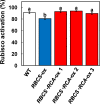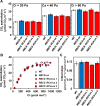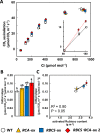Co-overproducing Rubisco and Rubisco activase enhances photosynthesis in the optimal temperature range in rice
- PMID: 33631807
- PMCID: PMC8133551
- DOI: 10.1093/plphys/kiaa026
Co-overproducing Rubisco and Rubisco activase enhances photosynthesis in the optimal temperature range in rice
Abstract
Rubisco limits C3 photosynthesis under some conditions and is therefore a potential target for improving photosynthetic efficiency. The overproduction of Rubisco is often accompanied by a decline in Rubisco activation, and the protein ratio of Rubisco activase (RCA) to Rubisco (RCA/Rubisco) greatly decreases in Rubisco-overproducing plants (RBCS-ox). Here, we produced transgenic rice (Oryza sativa) plants co-overproducing both Rubisco and RCA (RBCS-RCA-ox). Rubisco content in RBCS-RCA-ox plants increased by 23%-44%, and RCA/Rubisco levels were similar or higher than those of wild-type plants. However, although the activation state of Rubisco in RBCS-RCA-ox plants was enhanced, the rates of CO2 assimilation at 25°C in RBCS-RCA-ox plants did not differ from that of wild-type plants. Alternatively, at a moderately high temperature (optimal range of 32°C-36°C), the rates of CO2 assimilation in RBCS-ox and RBCS-RCA-ox plants were higher than in wild-type plants under conditions equal to or lower than current atmospheric CO2 levels. The activation state of Rubisco in RBCS-RCA-ox remained higher than that of RBCS-ox plants, and activated Rubisco content in RCA overproducing, RBCS-ox, RBCS-RCA-ox, and wild-type plants was highly correlated with the initial slope of CO2 assimilation against intercellular CO2 pressures (A:Ci) at 36°C. Thus, a simultaneous increase in Rubisco and RCA contents leads to enhanced photosynthesis within the optimal temperature range.
© American Society of Plant Biologists 2020. All rights reserved. For permissions, please email: journals.permissions@oup.com.
Figures







Similar articles
-
Effects of Overproduction of Rubisco Activase on Rubisco Content in Transgenic Rice Grown at Different N Levels.Int J Mol Sci. 2020 Feb 27;21(5):1626. doi: 10.3390/ijms21051626. Int J Mol Sci. 2020. PMID: 32120887 Free PMC article.
-
A Small Decrease in Rubisco Content by Individual Suppression of RBCS Genes Leads to Improvement of Photosynthesis and Greater Biomass Production in Rice Under Conditions of Elevated CO2.Plant Cell Physiol. 2017 Mar 1;58(3):635-642. doi: 10.1093/pcp/pcx018. Plant Cell Physiol. 2017. PMID: 28158810
-
Whole-plant growth and N utilization in transgenic rice plants with increased or decreased Rubisco content under different CO2 partial pressures.Plant Cell Physiol. 2014 Nov;55(11):1905-11. doi: 10.1093/pcp/pcu119. Epub 2014 Sep 16. Plant Cell Physiol. 2014. PMID: 25231963
-
Optimizing Rubisco and its regulation for greater resource use efficiency.Plant Cell Environ. 2015 Sep;38(9):1817-32. doi: 10.1111/pce.12425. Epub 2014 Sep 26. Plant Cell Environ. 2015. PMID: 25123951 Review.
-
Photosynthesis, plant growth and N allocation in transgenic rice plants with decreased Rubisco under CO2 enrichment.J Exp Bot. 2000 Feb;51 Spec No:383-9. doi: 10.1093/jexbot/51.suppl_1.383. J Exp Bot. 2000. PMID: 10938846 Review.
Cited by
-
Regulation of Calvin-Benson cycle enzymes under high temperature stress.aBIOTECH. 2022 Jan 24;3(1):65-77. doi: 10.1007/s42994-022-00068-3. eCollection 2022 Mar. aBIOTECH. 2022. PMID: 36311539 Free PMC article. Review.
-
The combined formulation of brassinolide and pyraclostrobin increases biomass and seed yield by improving photosynthetic capacity in Arabidopsis thaliana.Front Plant Sci. 2023 Mar 29;14:1138563. doi: 10.3389/fpls.2023.1138563. eCollection 2023. Front Plant Sci. 2023. PMID: 37063198 Free PMC article.
-
Reduced Carbon Dioxide by Overexpressing EPSPS Transgene in Arabidopsis and Rice: Implications in Carbon Neutrality through Genetically Engineered Plants.Biology (Basel). 2023 Dec 31;13(1):25. doi: 10.3390/biology13010025. Biology (Basel). 2023. PMID: 38248456 Free PMC article.
-
Nanobionics in Crop Production: An Emerging Approach to Modulate Plant Functionalities.Plants (Basel). 2022 Mar 4;11(5):692. doi: 10.3390/plants11050692. Plants (Basel). 2022. PMID: 35270162 Free PMC article. Review.
-
Genetic improvement of phosphate-limited photosynthesis for high yield in rice.Proc Natl Acad Sci U S A. 2024 Aug 20;121(34):e2404199121. doi: 10.1073/pnas.2404199121. Epub 2024 Aug 13. Proc Natl Acad Sci U S A. 2024. PMID: 39136985 Free PMC article.
References
-
- Bracher A, Whitney SM, Hartl FU, Hayer-Hartl M (2017) Biogenesis and metabolic maintenance of Rubisco. Annu Rev of Plant Biol 68: 29–60 - PubMed
-
- Busch FA, Sage RF (2017) The sensitivity of photosynthesis to O2 and CO2 concentration identifies strong Rubisco control above the thermal optimum. New Phytol 213: 1036–1051 - PubMed
-
- Carmo-Silva AE, Scales JC, Madgwick PJ, Parry MA (2015) Optimizing Rubisco and its regulation for greater resource use efficiency. Plant Cell Environ 38: 1817–1832 - PubMed
Publication types
MeSH terms
Substances
LinkOut - more resources
Full Text Sources
Miscellaneous

